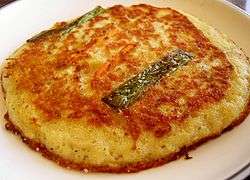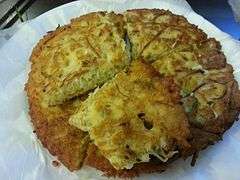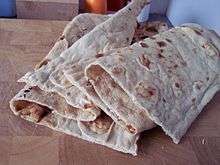Bindaetteok
 | |
| Alternative names | Nokdujeon, nokdu jijim |
|---|---|
| Type | Jeon |
| Place of origin | Korea |
| Main ingredients | Mung beans, green onions, kimchi, or peppers |
|
| |
| Bindaetteok | |
| Hangul | 빈대떡, 녹두전, 녹두지짐 |
|---|---|
| Hanja | None, 绿豆煎, 绿豆지짐 |
| Revised Romanization | bindaetteok, nokdujeon, nokdu jijim |
| McCune–Reischauer | pindaettŏk, noktujŏn, noktu chijim |
Bindaetteok (also called nokdujeon or nokdu jijim; literally "mung bean pancake") is a variety of jeon, a Korean style pancake. It is made of ground mung beans, with green onions, kimchi, or peppers cooked in a frying pan.
History
Bindaetteok first appears under the name binjatteok in the Eumsik dimibang, a cooking encyclopedia written in the 1670s by Mrs. Jang, the wife of a public officer. The dish was originally prepared by frying a mixture of water-soaked and ground mung beans, pork, bracken fern, mung bean sprouts, and cabbage kimchi.[1] This food uses honey for seasoning, and meat was put on the bindaetteok. Rich people ate meat and poor people ate bindaetteok. Therefore, this dish was called bindaebyeong (貧乏餅; literally "poor person's pancake").
Ingredients
- 1/2 cup mung beans, soaked overnight
- 1 large egg (optional)
- 1/4 cup cabbage kimchi
- 1/2 tbsp toasted sesame oil
- 1/4 tsp salt[2]
Meat, usually pork or beef, can also be added as an ingredient. In Korean restaurants, this dish is served with a small side serving of dipping sauce made of soy sauce, minced green onions, chili pepper flakes and some vinegar.
Gallery
See also
References
- ↑ Korean Food Series (5th Issue) http://www.pennfamily.org/KSS-USA/20050615-2440.htm
- ↑ Verdant San Francisco: Bindaetteok
External links
| Wikimedia Commons has media related to Bindaetteok. |
- (Korean) General information about Bindaetteok at Doosan Encyclopedia: Encyber
- (Korean) Brief information about Bindaetteok at DAUM encyclopedia
- (Korean) Origin and brief information about Bindaetteok at empas/ EncyKorea
- Kwangjang Market: Delicious Charm Bindaetteok at Official Seoul City Tourism

